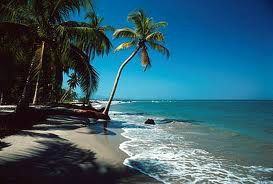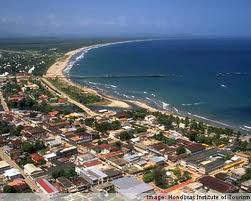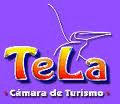SEE-HONDURAS
Tela
Tela was founded by the conquistador Cristobal de Olid the third of May 1524. Because of the date, which the Catholic Religion dedicates as the day of the Holy Cross, the city was given the name of Triunfo de la Cruz. As it was a rather long name, it was soon abbreviated as T. de la +, and by 1829 it was referred to as Tela. The name Triunfo de la Cruz was retained by a small hill that slopes into the Caribbean Sea, next to the city.
of the Holy Cross, the city was given the name of Triunfo de la Cruz. As it was a rather long name, it was soon abbreviated as T. de la +, and by 1829 it was referred to as Tela. The name Triunfo de la Cruz was retained by a small hill that slopes into the Caribbean Sea, next to the city.
Originally, this township was founded next to an Indian community called Tehuacan, which had good drinking water, food, medicinal plants and everything else necessary to lead a good life, and it was part or the territory controlled by Cucumba, a local lord who lived on the other side of the Ulua River.
The natives lived in large houses built of stilts and were skilled navigators of the shores of the Gulf of Honduras.com By the end of the XVI century, the Bay of Tela was frequented by buccaneers, looking to take the bounty that the Spanish ships carried to Spain.
The Trujillo-Puerto Cortes, La Havana route constantly provided sips laden with gold that were easy prey. Testimony of this period in Tela´s history are the names of Turn Bay (today Tornabe), and Punta Bishop (today Punta Izopo).
The Garifunas were taken from the Island of St. Vincent and marooned on the Island of Roatan in 1797; They were later moved by the Spaniards to Trujillo from where they dispersed along the coast. By 1808 they had established themselves in Tela and stayed there until 1889. `They established their own communities due to social and economic reasons.


One of these was established to the east of El Triunfo Hill, which they called Triunfo de la Cruz, and another to the west which was called San Juan. Between 1860 and 1900, the economy was based on the banana crop, which was promoted by the municipality and was conducted on a small scale; between 1900 and 1912 small concessions were issued by the government to locals and foreigners that helped improve the economic outlook of Tela.
During these periods, the municipality of Tela was given form: its territorial boundaries, municipal land, public lighting, water sources, schools, etc.
The third stage of capitalistic development begins in 1912, with the huge land concession made to the Tela Railroad Company that monopolized the banana plantations. This stage caused drastic changes in the social and economic structure of Tela.
This period finalized in 1976, when the Tela Railroad Company moved its offices to the City of La Lima. Since then, there has been a steady development in tourism, cattle ranching, as well as agriculture. When visiting Tela, you will see the old traditional part of the city, consisting in the old Spanish style of building.
A main square or park, with the church, municipal hall and school around it. In addition, Tela Nueva, which is the part of the city where the banana company set its operation, includes the old railroad building and the housing complex where the executives of the company made their homes.
Today you will find that Tela offers a delightful mix of Spanish, Indigenous and Garifuna races, with lifestyles from all of these different cultures.
Punta Izopo National Park Located on the eastern end of the bay of Tela, only 12 km from town, and this unique area takes its name from the small mountain that dominates the area and comes out into the Caribbean: Izopo Mountain. The exuberant vegetation of the area.
Which is irrigated by the Platano and Hicaque rivers, is home to large variety of wildlife, including tropical birds such as parrots and toucans, monkeys, alligators and turtles?


The canals, formed within the mangrove forests are accessible to sea kayaks, which permit you to silently enter the area without disturbing the natural beauty, and come close to the birds and other wildlife.
This tour also includes the opportunity of visiting the Garifuna town of Triunfo de la Cruz, where the Spanish Conquistador, Cristobal de Olid first disembarked on his quest to conquer Honduras, following orders of Hernan Cortes.
 of the Holy Cross, the city was given the name of Triunfo de la Cruz. As it was a rather long name, it was soon abbreviated as T. de la +, and by 1829 it was referred to as Tela. The name Triunfo de la Cruz was retained by a small hill that slopes into the Caribbean Sea, next to the city.
of the Holy Cross, the city was given the name of Triunfo de la Cruz. As it was a rather long name, it was soon abbreviated as T. de la +, and by 1829 it was referred to as Tela. The name Triunfo de la Cruz was retained by a small hill that slopes into the Caribbean Sea, next to the city.Originally, this township was founded next to an Indian community called Tehuacan, which had good drinking water, food, medicinal plants and everything else necessary to lead a good life, and it was part or the territory controlled by Cucumba, a local lord who lived on the other side of the Ulua River.
The natives lived in large houses built of stilts and were skilled navigators of the shores of the Gulf of Honduras.com By the end of the XVI century, the Bay of Tela was frequented by buccaneers, looking to take the bounty that the Spanish ships carried to Spain.
The Trujillo-Puerto Cortes, La Havana route constantly provided sips laden with gold that were easy prey. Testimony of this period in Tela´s history are the names of Turn Bay (today Tornabe), and Punta Bishop (today Punta Izopo).
The Garifunas were taken from the Island of St. Vincent and marooned on the Island of Roatan in 1797; They were later moved by the Spaniards to Trujillo from where they dispersed along the coast. By 1808 they had established themselves in Tela and stayed there until 1889. `They established their own communities due to social and economic reasons.


One of these was established to the east of El Triunfo Hill, which they called Triunfo de la Cruz, and another to the west which was called San Juan. Between 1860 and 1900, the economy was based on the banana crop, which was promoted by the municipality and was conducted on a small scale; between 1900 and 1912 small concessions were issued by the government to locals and foreigners that helped improve the economic outlook of Tela.
During these periods, the municipality of Tela was given form: its territorial boundaries, municipal land, public lighting, water sources, schools, etc.
GANE DINERO POR MEDIO DE LA RED
The third stage of capitalistic development begins in 1912, with the huge land concession made to the Tela Railroad Company that monopolized the banana plantations. This stage caused drastic changes in the social and economic structure of Tela.
This period finalized in 1976, when the Tela Railroad Company moved its offices to the City of La Lima. Since then, there has been a steady development in tourism, cattle ranching, as well as agriculture. When visiting Tela, you will see the old traditional part of the city, consisting in the old Spanish style of building.
A main square or park, with the church, municipal hall and school around it. In addition, Tela Nueva, which is the part of the city where the banana company set its operation, includes the old railroad building and the housing complex where the executives of the company made their homes.
Today you will find that Tela offers a delightful mix of Spanish, Indigenous and Garifuna races, with lifestyles from all of these different cultures.
Punta Izopo National Park Located on the eastern end of the bay of Tela, only 12 km from town, and this unique area takes its name from the small mountain that dominates the area and comes out into the Caribbean: Izopo Mountain. The exuberant vegetation of the area.
Which is irrigated by the Platano and Hicaque rivers, is home to large variety of wildlife, including tropical birds such as parrots and toucans, monkeys, alligators and turtles?


The canals, formed within the mangrove forests are accessible to sea kayaks, which permit you to silently enter the area without disturbing the natural beauty, and come close to the birds and other wildlife.
This tour also includes the opportunity of visiting the Garifuna town of Triunfo de la Cruz, where the Spanish Conquistador, Cristobal de Olid first disembarked on his quest to conquer Honduras, following orders of Hernan Cortes.
 UP-ARRIBA |


